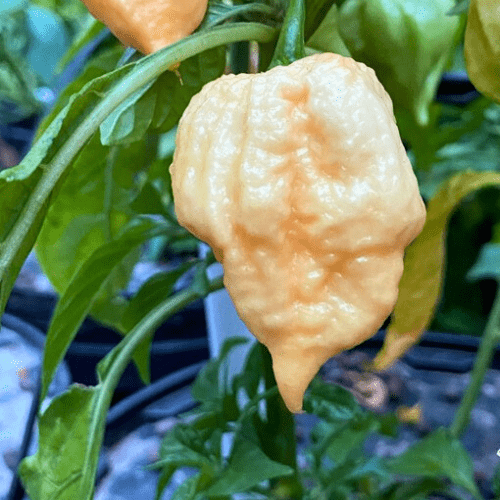Position
Full sun is crucial. Aim for at least 6 to 8 hours of direct sunlight each day. Consider growing them in containers if you have limited space or want to control their environment better. Take them indoors during winter.
Soil
Before planting Ghost Peppers, enrich the soil with compost or well-rotted manure to improve fertility. For exceptional growth, add half a bag of our Volcanic Rock Dust (R25 per bag) and a bag of Superfrass (R25 per bag) into your soil before planting.
The soil must drain well to prevent root rot.
Watering
Water deeply but infrequently, allowing the soil to dry out between waterings. Mulching around the base of the plant can help retain moisture and keep the soil temperature stable.
Mulch
Use from 2 to 5 centimetres of pine bark mulch to protect the roots from UV damage and drying out. It retains moisture and maintains an optimal pH. Do not let the mulch touch the plant stem, as it may cause infection or rot.
Re-apply every 3-4 months.
Pruning
Prune your Ghost Pepper plants regularly to remove dead or damaged leaves and encourage better airflow around the plant. This also helps the plant focus its energy on producing peppers rather than excessive foliage.
As the peppers grow, the plant may need support due to the weight of the peppers. Use stakes, cages, or trellises to help support the plant and prevent it from falling over.
Fertilising
Use a balanced fertiliser (such as 10-10-10) during planting and again every 4-6 weeks throughout the growing season to encourage healthy growth.
Too much nitrogen can lead to excessive foliage growth with little fruit production.
Apply 1 teaspoon every 4-5 months of our slow-release all-plant fertiliser. The roots will absorb what they need.
Pests & Diseases
Watch for pests like aphids, spider mites, and whiteflies.
Prevent fungal diseases like blight by providing good airflow and avoiding overhead watering. Crop rotation helps avoid soil-borne diseases.
Treat promptly or preferably use preventative measures by spraying with agricultural Neem Oil or Effective Microorganisms (EM Control)
Harvesting
Ghost Peppers are ready to harvest when they turn from green to vibrant red.
Use scissors or garden shears to cut the peppers off the plant, leaving a small stem attached. Wear gloves when handling Ghost Peppers, as their oils can cause skin irritation or a burning sensation
Post-Harvest Care
You can dry Ghost Peppers by hanging them in a well-ventilated area or using a dehydrator. Once dried, they can be ground into a powder or stored whole for future use.
Fresh peppers should be stored in a cool, dry place and used within a few weeks. Dried peppers can last for several months to a year when stored in airtight containers.






